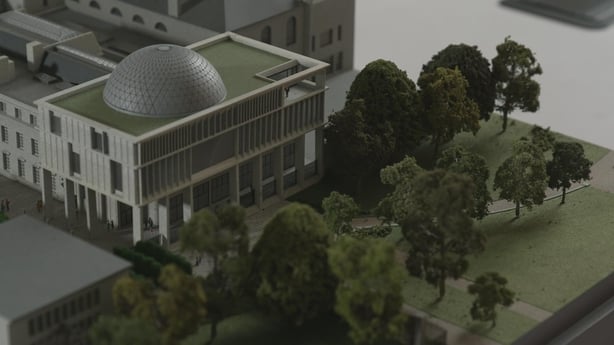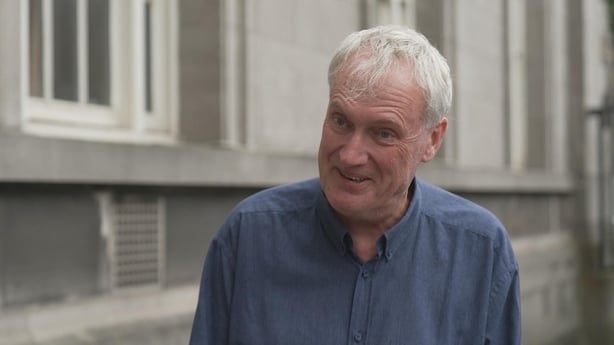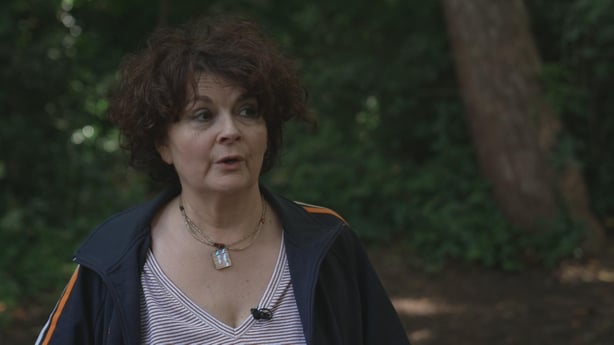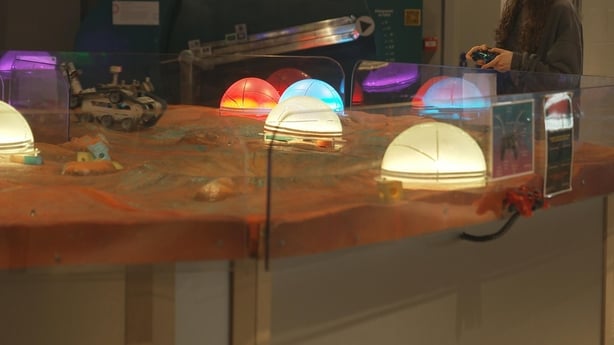A commitment by the Office of Public Works (OPW) to build a children's science museum may have exposed the State to a compensation payment of at least €26 million if it hadn’t agreed to deliver the project, according to a confidential legal document seen by Prime Time.
The Office of Public Works (OPW) is currently planning to build a 9,580sq/m National Children’s Science Centre at the northern wing of the National Concert Hall on Earlsfort Terrace in Dublin that is projected to cost at least €70m.
The project has been in the works since the 1990s and, in 2003, the OPW made an agreement with the charity promoting the science centre project, Irish Children’s Museum Limited, to build a "world class children’s science museum," in Ireland.
At the time the contract was agreed with the charity, the OPW’s plan was to sell a site near Heuston Station to a developer.
As a condition of sale, the developer would build the museum on part of the site at no financial cost to the taxpayer.
The intention was that the charity would then be responsible for operating the museum.
Planning permission was granted, but the collapse in the construction sector from around 2008 ended the prospect of the developer buying the site and building the science centre.
Subsequently, the OPW looked for a way to get out of its contract.
However, under the terms of the 2003 agreement, the OPW had a legal obligation to deliver the centre, according to a confidential legal opinion, which dates from 2013, seen by Prime Time.
Arbitration
In 2012, Irish Children’s Museum Limited wrote to the OPW saying that financial difficulties then faced by government agencies "do not excuse the OPW from fulfilling its legal obligations."
The charity threatened to force the OPW into binding arbitration.
"You sometimes have to fight for something that really matters," said Professor Áine Hyland, who has been involved with the science centre project for over 15 years.
"It's something that the country needs. And I believe that this National Children’s Science Centre is something that Ireland really needs," she said.

According to the legal opinion, which was prepared by two barristers, the OPW had no clear get-out clause. The State either had to build the museum or an arbitrator would likely order it to pay compensation to the charity.
"In theory," the legal document stated, "the arbitrator, should award [the Irish Children’s Museum Limited] the costs of construction of the museum, which may be as high as €26m."
In the view of the two barristers, "the award would be arguably higher" if the OPW did not provide the charity with a site.
Since the document was written in 2013, construction costs have risen substantially.
"I suspect it will be in the region of €70m," current chair of the OPW John Conlon told the Public Accounts Committee (PAC) in June.
Earlier this month, the PAC agreed to request a copy of the legal opinion from the OPW.
The OPW has said that 60% of that estimated €70m spend will go towards restoration and refurbishment of the historic north wing of the National Concert Hall, the current planned location for the new science centre.
Reluctant OPW
Despite its commitment to the project, the OPW has shown extreme reluctance about the science centre in the past.
"This is an extraordinary situation" and one about which "I am extremely concerned in terms of the possible exposure to the public purse," then OPW chair Maurice Buckley told the PAC in 2018.
"That project has never gone through the requirements of the spending code. I am not aware that it has gone through a cost-benefit analysis in its totality," Mr Buckley added.
The OPW declined to be interviewed by Prime Time, but former Managing Valuer Allen Morgan, who was not involved with the project, told Prime Time that the 2003 contract "…was far too open-ended and vague in terms of what commitments they were signing up to."
"They were signing up to a deal which was entirely dependent on the continuation of a buoyant property market where the State would get a commitment from a developer to build out the site and pay for this building," he said. "I think the risks probably weren't appreciated. The main risk being the way the market could change, which essentially is what happened."
The OPW declined to comment on the characterisation of its contractual agreement with Irish Children's Museum Ltd as open-ended and vague.
For many, building such a large science museum in the centre of Dublin is an ambitious and exciting plan.
"The goal is to make this the best children's science centre in the world," said Professor Luke O’Neill, who is on the board of Irish Children’s Museum Limited, the charity set up to promote the idea and ultimately operate the science centre.
"The kids will come in, they'll learn about science. It'll be very interactive… lots of virtual reality," Prof O’Neill added.

Threat to Iveagh Gardens
But for others, it is a building that duplicates what already exists and potentially damages a part of a much-loved public park, the adjoining Iveagh Gardens, which will be impacted by the removal of a 52m section of a high wall that currently separates the gardens from the National Concert Hall where the science centre will be situated.
There will be further impact from the removal of four trees - including a prized so-called 'Category A' tree - and destruction in part of a wooded area to allow access to the science centre from the park.
Annually, over 400,000 people use the Iveagh Gardens according to figures from the OPW, which also manages the park.
An unknown number of those are local residents who have no garden. People such as actress Pom Boyd, who, like others Prime Time spoke to, praises the way in which the OPW maintains the park.
For her, the park is "an oasis" in the heart of a "very busy, fast-growing city. There are very few places for people without gardens like me… to come and commune with nature to hear the birds," she said.
Ms Boyd is worried that the removal of such a large section of the boundary wall will harm what she describes as a "very delicately balanced Victorian garden." The wall "…is one of the things that gives the Iveagh Gardens its character," she said. She organised a petition which gathered over 46,900 signatures from people objecting to the plan and its impact on the Gardens.

A 2022 report by Dublin City Council Conservation officers stated that the removal of part of the boundary wall will "have an irreversible direct impact on the established quiet and mysterious quality" of the park and that the removal of trees would impact "...the 'wilderness' character and sense of enclosure."
However, a 2024 report from the An Bord Pleanála official who recommended planning permission be granted concluded that "The overall size of the Iveagh Gardens will not be reduced and ... there will be no loss of amenity or impact on existing park users" from the development.
The charity that has driven the project since its inception over 25 years ago agrees that the impact will be minimal and the vast bulk of the park will be unhindered by the development.
Professor Áine Hyland points to the An Bord Pleanála report on the project, which states "The proposed development is not removing any green space and is restoring an historical connection between the site and the Iveagh Gardens."
The OPW said that "As with the delivery of similar projects at sensitive sites, the OPW would have full regard for the protection of the historic Iveagh Gardens."
Prof O’Neill says the planned science centre will be "extremely important" for Ireland "to maintain our competitiveness."
"It'll be a public private partnership," he says, referring to the exhibits and the future operation of the centre rather than its construction.
"I'm very close to the pharmaceutical companies. Nine out of 10 of them are in Ireland, 50% of our exports are drugs. They have to get involved in this because they will hopefully want to educate our people to go and work in these very high-tech places. Those medicines are extremely high tech, very scientific. What better place to illustrate that than in a children's science centre?"
Explorium
Some question whether another large science centre is needed at all. When the project was first mooted in the 1990s, there was no other similar facility in the city. Now there is. In 2018, Explorium opened in Dublin’s Sandyford, 18 months after private investors bought a disused gym on 20 acres and converted it.
"We have over 250 interactive exhibits. We have incredible technology and augmented reality technology," said Charlie Kelly who is part owner and managing director of the centre.
"Explorium has been a big success and, and of course school kids love it," says Prof O’Neill, "Some of their ideas we might rip off and bring them in here," he says, jokingly.

Explorium has recently reopened after closing during the pandemic. It attracted 230,000 visitors in its only full year of business in 2019. But with a state-backed competitor on the horizon, its future is less certain.
"Obviously we've put a lot of time investment into our staff and we employ over 130 people here currently," said Mr Kelly. "So what the future looks like with two science centres within 10 kilometres of each other, it's hard to know. We're confident in our offer. We're confident in our future, but it's still hard to call it at this stage."
Mr Kelly questions the need to spend public money on a second science centre, which will be a little smaller in size than his facility.
"When you have a world class science centre 10km away from the city center, which can cater for the needs of the Irish population, young and old" there is no "rhyme or reason" to build a second centre "and invest €70 million plus" of public money, he says. "It seems non-logical."
We need your consent to load this Datawrapper contentWe use Datawrapper to manage extra content that can set cookies on your device and collect data about your activity. Please review their details and accept them to load the content.Manage Preferences
Explorium has said money and time could be saved if, instead of constructing a new building, the National Children's Science Centre, took over its existing facility or even assumed control of its board.
"We've tried to engage" with the Irish Children’s Museum charity, to "highlight the resource and the centre we have here, to try and work with them in some way in some form," he says. "But thus far they haven't engaged." Not formally at least, he says. "One of them visited..." he said, but there has been very little engagement beyond that.

Professor Áine Hyland says she could see the two centres "working together collaboratively" in the future.
But she suggests there is no room for a change of heart over the central Dublin location of the National Children's Science Centre.
"The plan and the aim and the ambition of the National Children's Science Centre, now that we have this building and the planning permission has been given, is to move forward to use this building and to move ahead. And in due course, we will be very open to partnerships with other bodies."
She believes Dublin and Ireland are big enough to support two major science institutions.
"We could have a population of seven million in 35 years time," she says. "Science is very, very important for the future of Ireland." A second major science centre would represent "one of the best investments that Ireland can make."
Professor Hyland said she expects the centre to open in 2028. That would be 25 years after the OPW agreed its contract with Irish Children’s Museum Limited to deliver the facility.
However, the OPW said today that "the timeline for the project works have yet to be finalised."
It also said that "This project has been subject to an arbitration process that is not yet finalised. The development of the project will be subject to the final arbitration decision, which is expected to conclude over the coming period."
The OPW said its remit is to provide a building to house the National Children’s Science Centre. It is "currently reviewing the planning conditions" as set out by An Bord Pleanála, in its decision to grant planning permission in March.
It also said that "Funding arrangements for the project will need to be considered by Government."
Watch the full report from Paul Murphy and producer Sallyanne Godson on the 25 July edition of Prime Time on RTÉ One and RTÉ Player.






